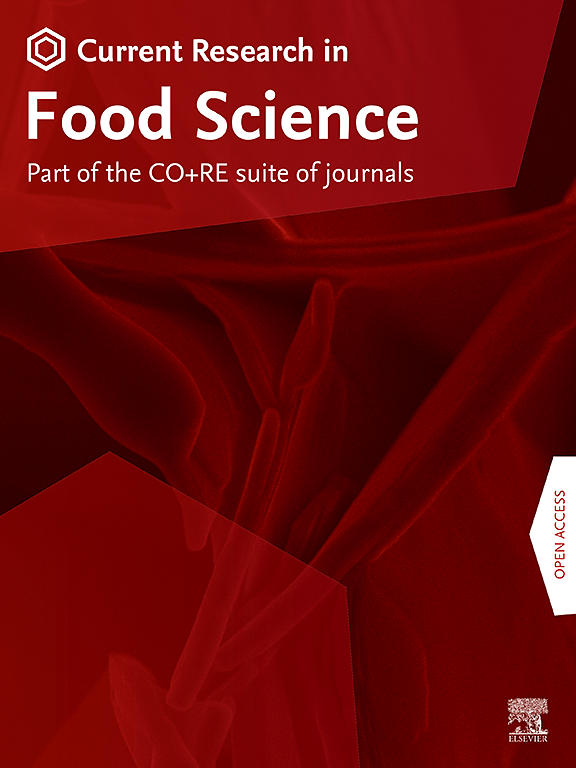脉冲电场处理可食用昆虫浆诱导热辅助微生物失活。
IF 7
2区 农林科学
Q1 FOOD SCIENCE & TECHNOLOGY
引用次数: 0
摘要
以昆虫为基础的食品成分正在成为可持续的蛋白质来源,但它们的生产需要确保微生物安全性和内源性酶的失活,以避免不良的蛋白质水解,同时不损害蛋白质结构。虽然传统的热处理会影响蛋白质结构,但脉冲电场(PEF)技术在pH为3的情况下灭活小粉虫和蟋蟀浆中的微生物,同时保留天然蛋白质结构的潜力尚未得到探索。对pH为3的小粉虫和蟋蟀浆进行连续和间歇不同强度(0 ~ 450 kJ/kg)的PEF处理。对微生物失活(需氧菌、厌氧菌、酵母和霉菌)、温度变化、蛋白质溶解度、蛋白质结构(SDS-PAGE和FTIR)和内源性蛋白酶活性进行了评估。对于这两种昆虫,高强度PEF (>150 kJ/kg)可实现高达5 log的微生物减少,但升高温度高达75°C,改变蛋白质结构。低强度PEF不影响蛋白质构象和蛋白酶活性,但对微生物灭活无效(本文章由计算机程序翻译,如有差异,请以英文原文为准。

Pulsed electric field processing of edible insect slurries induces thermally-assisted microbial inactivation
Insect-based food ingredients are emerging as sustainable protein sources, but their production requires ensuring microbial safety and inactivation of endogenous enzymes to avoid undesirable proteolysis, without compromising protein structure. While traditional thermal processing affects the protein structure, the potential of pulsed electric field (PEF) technology to inactivate microorganisms in lesser mealworm and house cricket slurries at pH 3 while simultaneously retaining the native protein structure is yet unexplored.
Lesser mealworm and house cricket slurries at pH 3 were subjected to continuous and batch PEF treatments with varying intensities (0–450 kJ/kg). Microbial inactivation (aerobes, anaerobes, yeasts, and moulds), temperature changes, protein solubility, protein structure (SDS-PAGE and FTIR), and endogenous protease activity were assessed.
For both insect species, high-intensity PEF (>150 kJ/kg) achieved up to 5 log microbial reduction, but increased temperatures up to 75 °C, altering protein structure. Low-intensity PEF did not affect protein conformation and protease activity, but was not effective in microbial inactivation (<1 log reduction).
We conclude that while PEF can effectively inactivate microorganisms, it cannot be considered a non-thermal method for the present sample conditions due to the temperature increase at higher intensities. PEF could be well-suitable for incorporation in hurdle techniques, such as combinations with moderate heating. Future research should investigate synergistic effects of PEF, also for using alternative PEF set-ups, with other mild processing techniques for effective microbial inactivation while preserving native protein structure. Furthermore, optimal PEF intensities for enhanced protein solubility should be explored.
求助全文
通过发布文献求助,成功后即可免费获取论文全文。
去求助
来源期刊

Current Research in Food Science
Agricultural and Biological Sciences-Food Science
CiteScore
7.40
自引率
3.20%
发文量
232
审稿时长
84 days
期刊介绍:
Current Research in Food Science is an international peer-reviewed journal dedicated to advancing the breadth of knowledge in the field of food science. It serves as a platform for publishing original research articles and short communications that encompass a wide array of topics, including food chemistry, physics, microbiology, nutrition, nutraceuticals, process and package engineering, materials science, food sustainability, and food security. By covering these diverse areas, the journal aims to provide a comprehensive source of the latest scientific findings and technological advancements that are shaping the future of the food industry. The journal's scope is designed to address the multidisciplinary nature of food science, reflecting its commitment to promoting innovation and ensuring the safety and quality of the food supply.
 求助内容:
求助内容: 应助结果提醒方式:
应助结果提醒方式:


